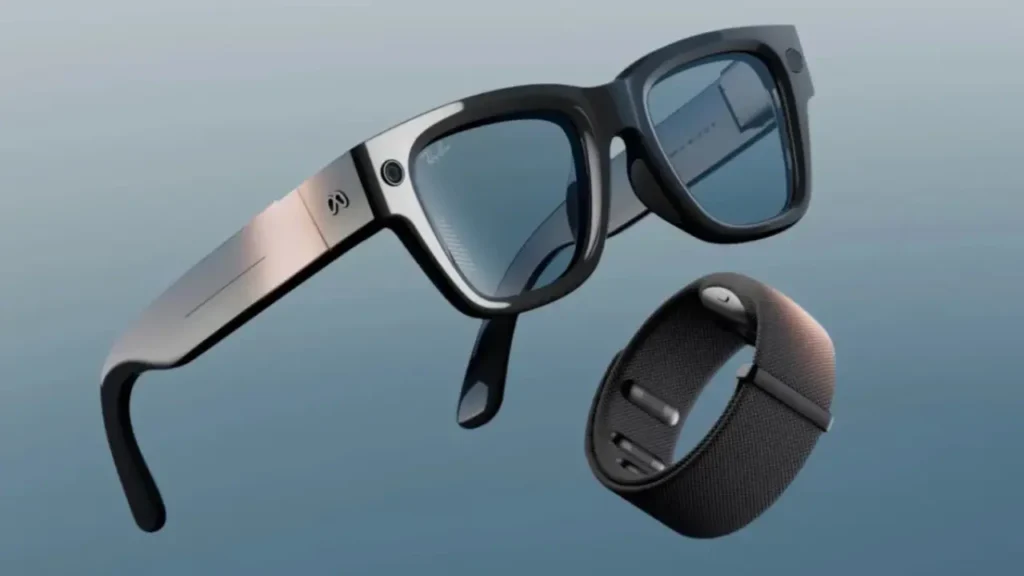
Meta has launched the new Meta Ray-Ban Display glasses, its most advanced smart eyewear for everyday use. These glasses cost 799 dollars, which is about 70,300 rupees in India. They combine a high quality display, gesture control using a wristband, and AI powered tools, all inside a classic Ray-Ban frame. With this launch Meta is taking a big step toward making smart glasses useful for real life, not just as a tech experiment.
Features of Meta Ray-Ban Display Glasses
The most special part of these glasses is the small display hidden in the right lens. It has a 600 by 600 pixel resolution and shows bright, full color visuals only when you need them. The brightness goes up to 5000 nits so the text and images are clear even in sunlight. From the outside the lens looks like normal eyewear, and people around you cannot see what is displayed.
Instead of using buttons or touch, these glasses work with the Meta Neural Band. This is a wristband that reads muscle signals from your fingers. Small gestures like moving a finger can let you scroll, select, adjust volume, or even write letters in the air to reply to messages. This makes the glasses much easier to use in daily situations.
The glasses also come with built in speakers and microphones. You can make calls, join video chats, and listen to music without needing earbuds. The lenses automatically adjust brightness to match the surroundings, so your vision stays natural.
Battery life is about six hours of mixed use. The charging case adds another thirty hours, while the Neural Band wristband lasts around eighteen hours on one charge. The wristband is also water resistant and made of Vectran, a strong material that was used in NASA’s Mars rover crash pads.
Another highlight is real time live captions and translations. If someone is speaking to you, the words can appear on the lens as text. If they are speaking in another language, the glasses can translate instantly. This can help both people with hearing difficulties and travelers in new countries.
Meta is trying to show how these glasses can be part of everyday life. You can check texts or directions without taking out your phone. You can reply silently during a movie or in a meeting. If you are walking in an unfamiliar place the glasses can guide you with turn by turn directions. For professionals such as police officers, factory staff, or field workers, having quick information in front of the eyes could be very useful.
Price and Availability in India
The glasses are priced at 799 dollars in the United States and will go on sale from 30 September 2025 at Best Buy and Sunglass Hut stores. At the moment they are available only in the US, but a global release is expected later. In India the price is likely to be around 70,000 to 72,000 rupees once they launch locally
Alongside the Display model, Meta also announced the Ray-Ban Meta Gen 2 priced at 379 dollars and the Oakley Meta Vanguard priced at 499 dollars, while only the Ray-Ban Display glasses feature a full display and Neural Band gesture control.
| Model | Price | Key Feature |
|---|---|---|
| Ray-Ban Meta Gen 2 | $379 | Camera + Audio |
| Oakley Meta Vanguard | $499 | Sporty Design + Smart Audio |
| Meta Ray-Ban Display | $799 | Display + Gesture Control + AI |
Meta envisions these glasses as the beginning of personal super intelligence. This means that AI shouldn’t just be limited to answering questions, but should also assist with tasks like memory, communication, and navigation. Some features, like making calls, didn’t work properly at the launch event, but things like Spotify playback worked fine. This clearly shows that the technology isn’t fully ready yet, but it has a great future.
The Meta Ray-Ban Display glasses bring together style and technology in a way that feels seamless. At first glance, they look like regular eyewear, but beneath that familiar design lies smart functionality that could change how people access and interact with information. Unlike earlier attempts such as Google Glass, these spectacles feel more practical and private, blending into everyday life without drawing unnecessary attention. If Meta continues to refine the experience, these could very well become the first smart glasses that truly win over the mainstream.



